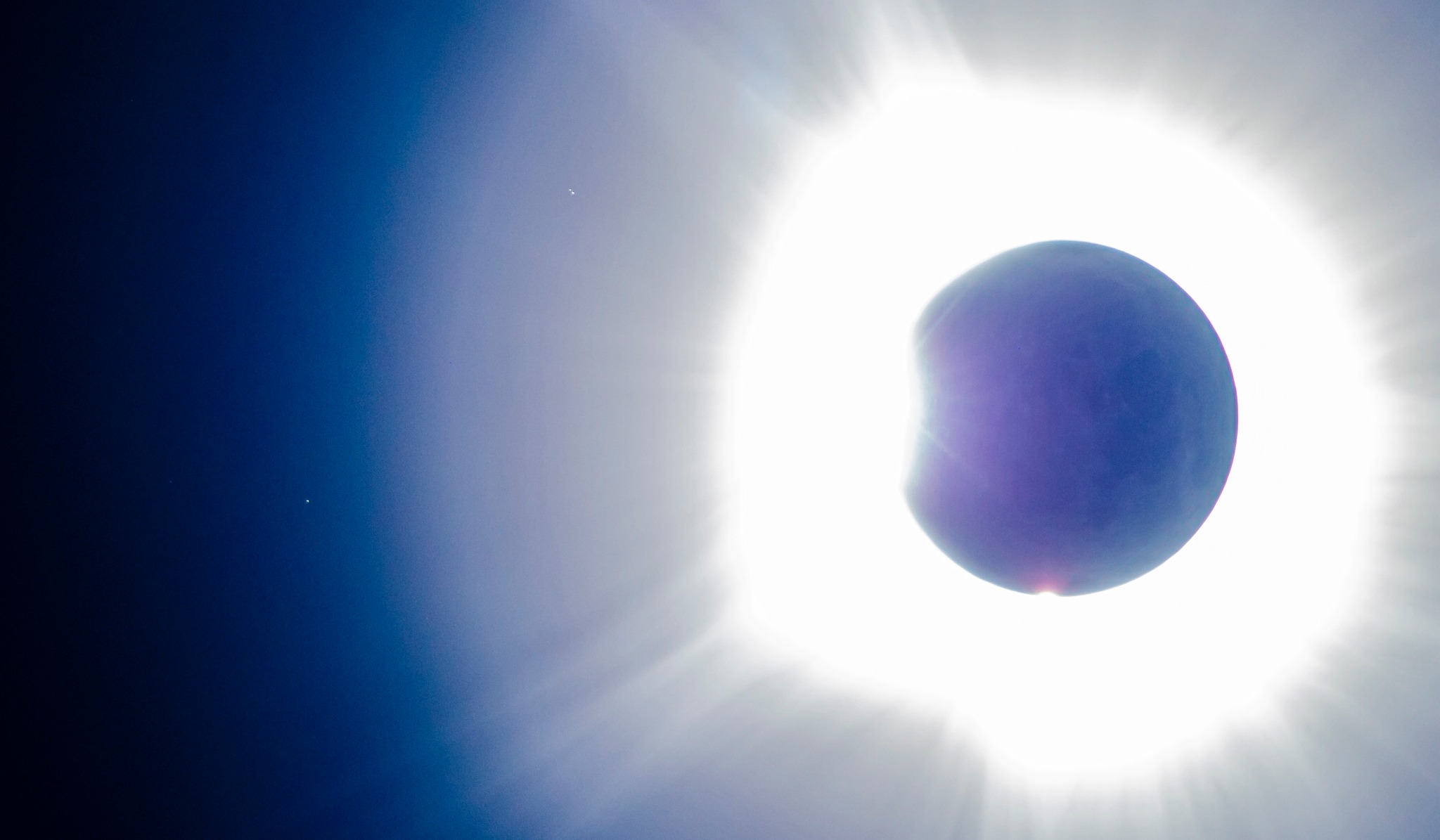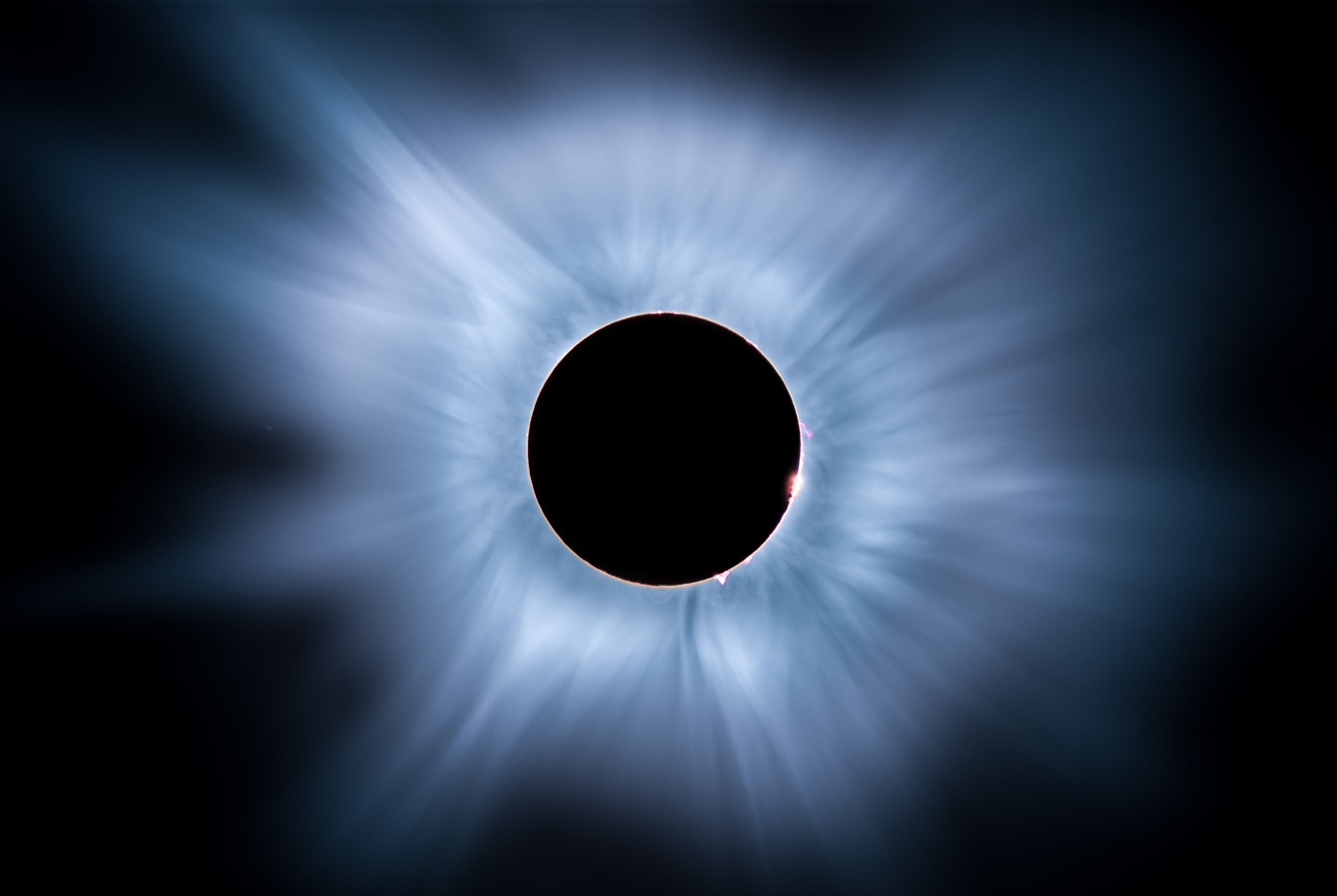I feel fortunate to have witnessed two total solar eclipses in my lifetime. The first was at Center Hill Lake in central Tennessee in 2017, then this year’s (April 8) eclipse from Paducah, Kentucky. Given my age (68), I doubt I will see another.
For those who have not witnessed one, many look at the resulting photos and say, “So what?”. When I look at most of the photos (including the ones I’ve taken) I can tell you that those photos do not fully reflect the visual experience. More on that in a minute.
Having daytime transition into night in a matter of seconds is one part of the experience, with the sounds of nature swiftly changing as birds and frogs suddenly realize, “Night sure came quickly today!”
It’s also cool to hear people around you respond to what they are witnessing. The air temperature becomes noticeably cooler. Scattered low clouds that might have threatened to get in the way mostly disappear, just as they do after sunset.
But why are so many photos of the event… well… underwhelming? After thinking about this over the past week, I believe the answer lies in the extreme range of brightness a solar eclipse produces that cameras (even good ones) have difficulty capturing. This is why individual photos you see will often look different from one another. Depending upon camera exposure settings, you will see different features.
This was made very apparent to me during this year’s eclipse. Due to terrible eclipse traffic, we had to stop short of our intended destination, and I had only 10 minutes to set up a telescope and two cameras, so some of my advance planning went out the window. I was watching the “diamond” of the diamond ring phase of totality, as the last little bit of direct sunlight disappears behind the moon. At that point, it is (in my opinion) possible with the naked eye to perceive a dynamic range greater than any other scene in nature: from direct sunlight of the tiny “diamond” to the adjacent night sky with stars. I took the following photo with a Canon 6D MkII camera with 560 mm of stacked Canon lenses, which (barely) shows this extreme range of brightness.

In order to pull out the faint Earthshine on the moon’s dark side in this photo, and the stars to the left and upper-left, I had to stretch this exposure by quite a lot.
From what I have read (and experienced) the human eye/brain combination can perceive a greater dynamic range of brightness than a camera can. This is why photographers have to fool so much with camera settings to capture what their eyes see. In this case, I perceived the “diamond” of direct sunlight was (of course) blindingly bright, while the sun’s corona extending 2 to 3 solar diameters away from the sun was much less bright (in fact, the solar corona is not even as bright as a full moon). But in this single photo, both the diamond and the corona were basically at the maximum brightness the camera could capture at this exposure setting (0.5 sec, ISO400, f/5.6), even though visually they had very different brightnesses.
Many of the better photos you will find are composites of multiple photos taken over a very wide range of camera settings, which more closely approximate what the eye sees. I found this one that seems closer to what I witnessed (photo by Mark Goodman):

So, if you have never experienced a total solar eclipse, and are underwhelmed by the photos you see, I submit that the actual experience is much more dramatic than the photos indicate.
Here’s some unedited real-time video I took with my Sony A7SII camera mounted on a Skywatcher Esprit ED80 refractor telescope. We were in a Pilot Travel Center parking lot with about a dozen other cars that also didn’t make it o their destinations due to the traffic. I used a solar filter until just before totality, then removed the filter. The camera is on an automatic exposure setting. I’ve done no color grading of the video. Skip ahead to the 3 minute mark to catch the transition to totality:

 Home/Blog
Home/Blog




…testing…
Roy Spencer
” Having daytime transition into night in a matter of seconds is one part of the experience, with the sounds of nature swiftly changing as birds and frogs suddenly realize, ‘Night sure came quickly today!’ ”
We couldn’t attend this event, as it was restricted to North America.
*
However, your words remind me and my lady of what we experienced on August 11, 1999 in Northern Germany.
We were a bit too far away from the 100% path
https://en.wikipedia.org/wiki/File:SE1999Aug11T.png
but the sudden silence in nature was amazing enough.
Thanks.
Thanks for sharing your eclipse story and the video.
The one in 2017 got obstructed by clouds so I could not see the effect. Glad you saw this one!
Dr Spencer,
Did you monitor air temperature or ground temperature during the eclipse?
I assume that the lowest temperatures would occur after totality, but the rate of temperature drop, and that of its subsequent recovery might indicate something about any supposed GHE.
I meant to do that, but did not have time since our trip took 2 hrs longer than expected.
Oh well. Thanks anyway. Sorry your trip didnt go according to plan. Not the sort of thing you can shrug off, and say “No problem, Ill do it next week.”.
I’ve seen quite a few interesting things, but never a total eclipse.
Congratulations for able to experience two (if my memory serves me correctly).
Nice pictures and video!
I drove a few hours to Vermont to see it. My son decided to see it with friends just outside the totality zone, and unfortunately they missed the magic. I can verify that seeing the totality is a qualitatively different experience from watching a partial eclipse. Well worth all the driving.
Failed on pictures, but it was better to just focus on this unique IRL experience.
Thank you for recounting your experience. You did well in spite of the difficulties.
I’ve had the good fortune to experience four totals so far in my 65 years. Well 3.5, as one of them was an annular, earlier this year.
To those who say “What’s he big deal?” I say, you just have to experience it to understand. The transition from partial to total in the last few seconds is simply breathtaking. Shivers run up and down your spine. The hairs stand up on your neck. People spontaneously cheer and clap.
Oh, I yeah saw an eclipse, people say, their expression neutral. “It wasn’t that big a deal.” That’s because you saw a partial, not a total, I say.The partial and the total experience are vastly different, as different as night is from day.
Helluva thing to look up and see that hole in the sky, rimmed by fire, to see the stars come out in midday, to hear the birds and beasts go suddenly quiet, to be surrounded by 360 degrees of sunset. There really is nothing else quite like it.
This topic of the dynamic range of light and photography is pretty interesting. The acknowledged master has to be Ansel Adams, using his “Zone System”. I once took an evening adult continuing education photography class at a local university, and the professor was fascinated with all things Ansel Adams. He introduced us to the Adams’ Zone System, but it was complicated and I was a too overwhelmed to absorb much. I remember it involved a lot of walking around with a light meter and other detailed planning; one shot might take days of planning, especially when the lighting at a particular time of day was critical. Obviously that presents severe challenges planning for a solar eclipse photograph, and limits the time available for longer exposures. Much of the planning can be done in advance, though, such as the luminance measures of the full moon in the relevant part of the sky, luminance of the star field, calculating apertures and exposure times, choosing the appropriate film speed and film characteristics, etc. But even with Ansel Adams’ expertise, multiple large-format cameras with multiple exposure settings would no doubt still be required to capture the desired dynamic range and detail.
That composite eclipse photo is really cool, at least for showing the corona. But the moon is a deep black featureless disk, unlike your photo that shows hints of the surface features of the moon. I can just begin to visualize what a super-stretched-dynamic-range photo of a total solar eclipse might look like: the corona would look like that composite, but surface features of the moon would be crisp and the star field would be crisp.
A vague hint of what Ansel Adams might have done with such a photograph:
https://upload.wikimedia.org/wikipedia/commons/8/84/Baton-practice-Manzanar-Adams.jpeg
Thanks for posting this clear image of the eclipse
.
Dear Dr. Roy Spencer,
Thank you so much for sharing your eclipse video and telling the story about seeing this amazing celestial phenomenon! I saw the eclipse from Mazatlan, Mexico. The weather got better than suggested by the weather reports…
Living in tiny Denmark means I have to travel to witness total solar eclipses. During the next one, August 12th 2026 in Spain, much of my family will gather in Galicia. It will be a much shorter one, so I think I will skip photographing and just look at the total phase using binoculars. The solar prominences seen on April 8th was luminous pink to the naked eye. It was my eclipse nr. 9, but I can’t remember seeing prominences that bright and colourful. Or is it the result of a failing memory? The location is important as you mention. My best location was the Chilean altiplano Nov. 3 1994, the eclipsed sun standing above snow covered twin volcanoes and vicunjas in the distance. The worst place a Thai train station Oct. 1995. My first eclipse in Finland July 1990 got clouded out and the one in the Faroe Islands March 2015: I only saw 5-10 seconds of totality plus the final diamond ring…
Also, I’d like to thank you so much for bringing very important information about climate change otherwise hard to get.
I have told the exact same story to people after 2017, where I was lucky enough to be in Franklin, NC where the umbra was peak length of darkness time about 20 miles away. So it was pretty long. The light all around you is different. I always would tell people it is sharper, and as I found out from this recent eclipse, the light around shadows acts more as a point source when in the full umbra and shadows have sharp lines; not blurry ones as in regular sunlight.
As I also told everyone, it was waaaaay more interesting than I ever thought it would be. Definitely worth a a gander if yo ever get the chance. Which for the USA will be a while.